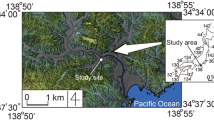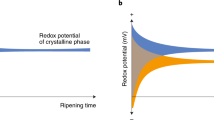Summary
Thorough studies of 28 water bodies, predominantly lakes from the younger moraine area of Schleswig-Holstein, Northern Germany but also some peat bog waters in Niedersachsen, Northern Germany and lake Balaton in Hungary, showed the presence of at least six redox systems: NO −3 /NO −2 ; NO −3 /NH +4 ; NO −2 /NH +4 ; SO/HS−; SO/H2S; and probably Fe(OH)3/Fe2+. Depending on the physicochemical conditions one of these becomes the dominant system determining the electric potential measured with the platinum electrode. The platinum electrode does not respond to any oxygen dominated redox system.
The corresponding theoretical redox equations seem to apply to almost all water bodies such as freshwater lakes, rivers, brackish water bodies, sea water and sometimes even humus rich water bodies from peat bogs and black water streams, hydromorphic soils, sediments and sewage sludge. The equations were found not to be valid for some heavily polluted effluents from lakes.
The following points are discussed on the basis of these findings:
-
the redox systems to which the normal platinum electrode reacts under natural conditions;
-
equations of redox systems relevant in natural waters;
-
methods of determination of the dominating redox system.
Similar content being viewed by others
References
Bagander LE, Niemisto L (1978) Evaluation of use of redox measurements for characterizing recent sediments. Estuarine Coastal Mar Sci 6 (2):127–134
Balzer W (1980) Redox dependant processes in the transition from oxic to anoxic conditions: an in-situ study concerning remineralization, nutrient release and heavy metal solubilization. In: Freeland HJ, Farmer DM, Levings CD (eds) Fjord Oceanography. Nato Conference Series. Plenum Press, New York London
Berner RA (1963) Electrode studies of hydrogen sulphide in marine sediments. Geochim Cosmochim Acta 27:563–575
Billen G (1975) Nitrification in the Scheldt Estuary (Belgium and the Netherlands). Estuarine Coastal Mar Sci 3:79–89
Bockris JO'M, Reddy AKN (1970) cited in Whitfield M (1972)
Borchardt JA (1967) Redoxpotential as an environmental parameter: conceptual significance and operational limitations: formal discussion. Proceedings of the International Water Pollution Research Conference (3rd Munich) 1:298–303
Boulegue J (1977) Equilibria in a sulfide rich water from Enghien-les-Bains, France. Geochim Cosmochim Acta 41 (12):1751–1756
Boulegue J, Michard G (1979) Sulfur speciations and redox processes in reducing environments. In: Jenne EA (ed) Chemical modeling in aqueous systems. ACS Symp Series93:25–49
Breck WG (1972) Redox potentials by equilibration. J Marine Res 30:121–139
Brümmer G (1974) Redoxpotentiale und Redoxprozesse von Mangan-, Eisen- und Schwefelverbindungen in hydromorphen Böden und Sedimenten. Geoderma 12:207–222
Brünger R (1981) Die thermodynamische Analyse von Redoxmessungen in eutrophen und dystrophen Gewässern und deren Anwendung zur Deutung des “Redox”-Jahresganges als Ausdruck botanisch-mikrobiologischer Stoffwechselprozesse in norddeutschen Gewässern. Dissertation, Osnabrück
Brünger R (1982) The redoxpotential as an indicator of microbial metabolic processes in North German waters. Radiat Environ Biophys 21:141–154
Champ DR, Gulens J, Jackson RE (1979) Oxidation-reduction sequences in ground-water flow systems. Can J Earth Sci 16 (1):12–23
Cooper LNH (1937/38) Oxidation-reduction potentials in sea water. J Marine Biol Ass UK 22:167–176
Emerson S (1976) Early diagenesis in anaerobic lake sediments: chemical equilibria in interstitial waters. Geochim Cosmochim Acta 40 (8):925–934
Hargrave BT (1972) Oxidation-reduction potentials, oxygen concentration and oxygen uptake of profundal sediments in an eutrophic lake. Oikos 23:167–177
Manheim FT (1961) In-situ measurements of pH and Eh in natural waters and sediments. Preliminary note on applications to a stagnant environment. Stockholm Contrib Geol 8:27–36
Müller HE (1976) Zur Morphologie pleistozäner Seebecken im westlichen schleswig-holsteinischen Jungmoränengebiet. Z Geomorphol 20:350–360
Müller HE (1977) Belastung und Belastungsdynamik in See-Umland-Systemen. Tagungsbericht and Wiss Abh, 41. Dt Geographentag in Mainz 1977, pp 499–517
Müller HE (1981) Die hydrochemische Dynamik stratifizierter Seen und Probleme zukünftiger Sanierungs- und Restaurierungsmaßnahmen. Beitr Hydrol, Sonderheft 2:57–76
Nordstrom DK, Jenne EA, Ball IW (1979) Redox equilibria of iron in acid mine-waters. In: Jenne EA (ed) Chemical modeling in aqueous systems. ACS Symp Series93:51–79
Prézner Zs (personal communication, 1984) University of Debrécen, Hungary
Sorokin YuI (1970) Interrelations between sulphur and carbon turnover in meromictic lakes. Arch Hydrobiol 66:391–445
Stumm W, Morgan JJ (1970) Aquatic chemistry. An introduction emphasizing chemical equilibria in natural waters. Wiley-Interscience, New York
Watanabe W, Devanathan MAV (1964) J Electrochem Soc111:615 ff (cited in: Stumm and Morgan 1970)
Whitfield M (1972) The electrochemical characteristics of natural redox cells. Limnol Oceanogr 17:383–393
ZoBell CE (1958) Ecology of sulfate reducing bacteria. Prod Mon 22:12–29
Author information
Authors and Affiliations
Rights and permissions
About this article
Cite this article
David, R. Dominating redox systems in lakes and rivers; thermodynamic interpretation of in-situ measurements with a platinum electrode. Radiat Environ Biophys 25, 219–229 (1986). https://doi.org/10.1007/BF01221229
Received:
Accepted:
Issue Date:
DOI: https://doi.org/10.1007/BF01221229




